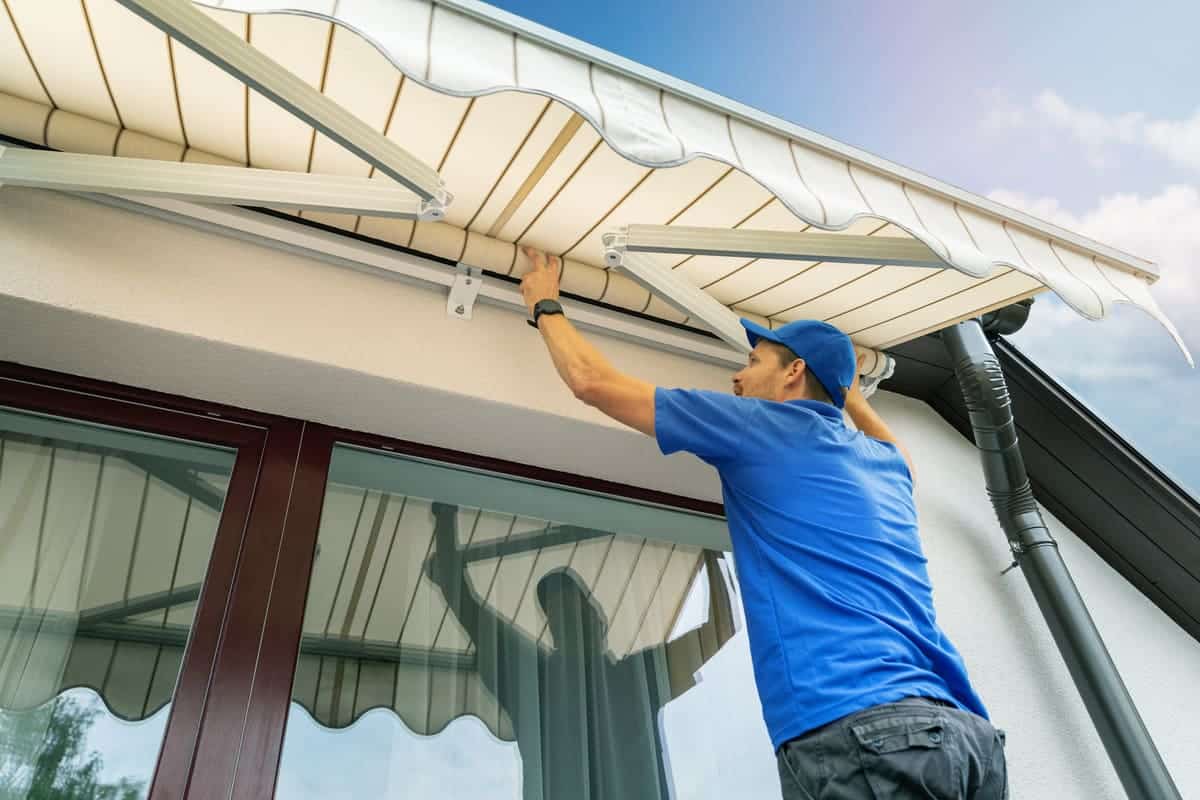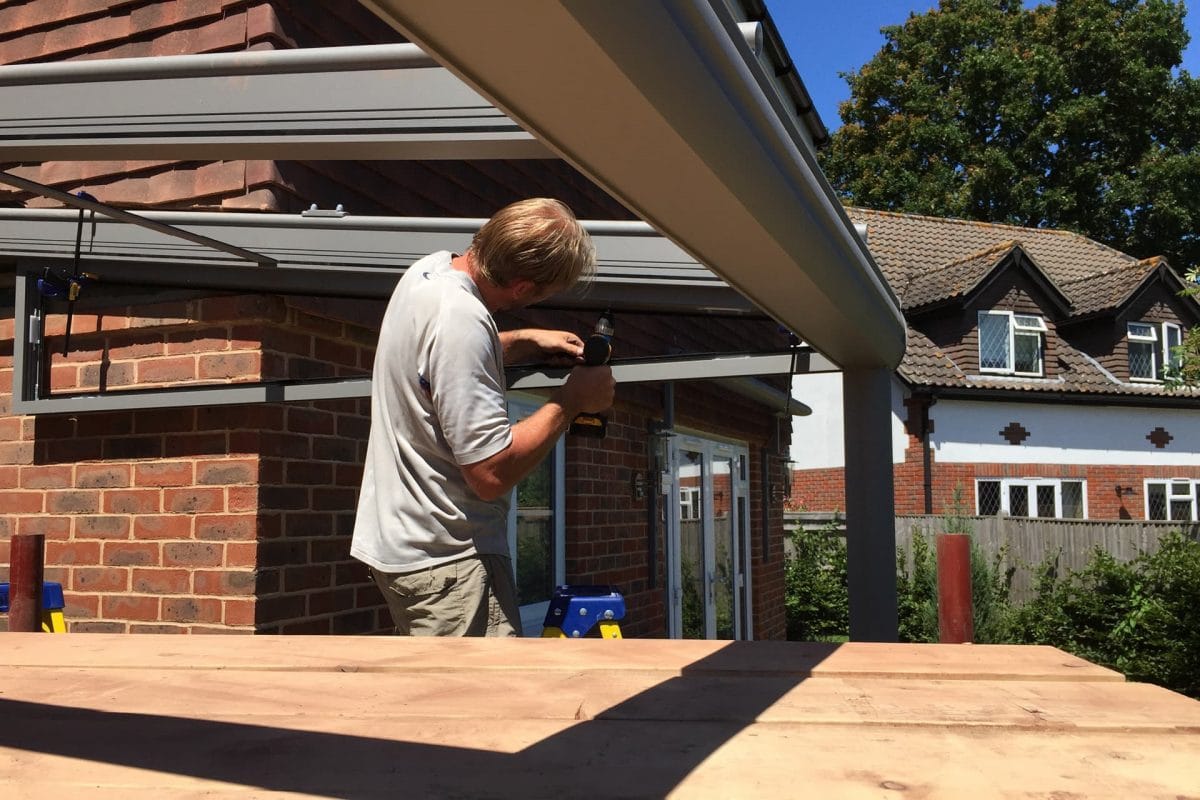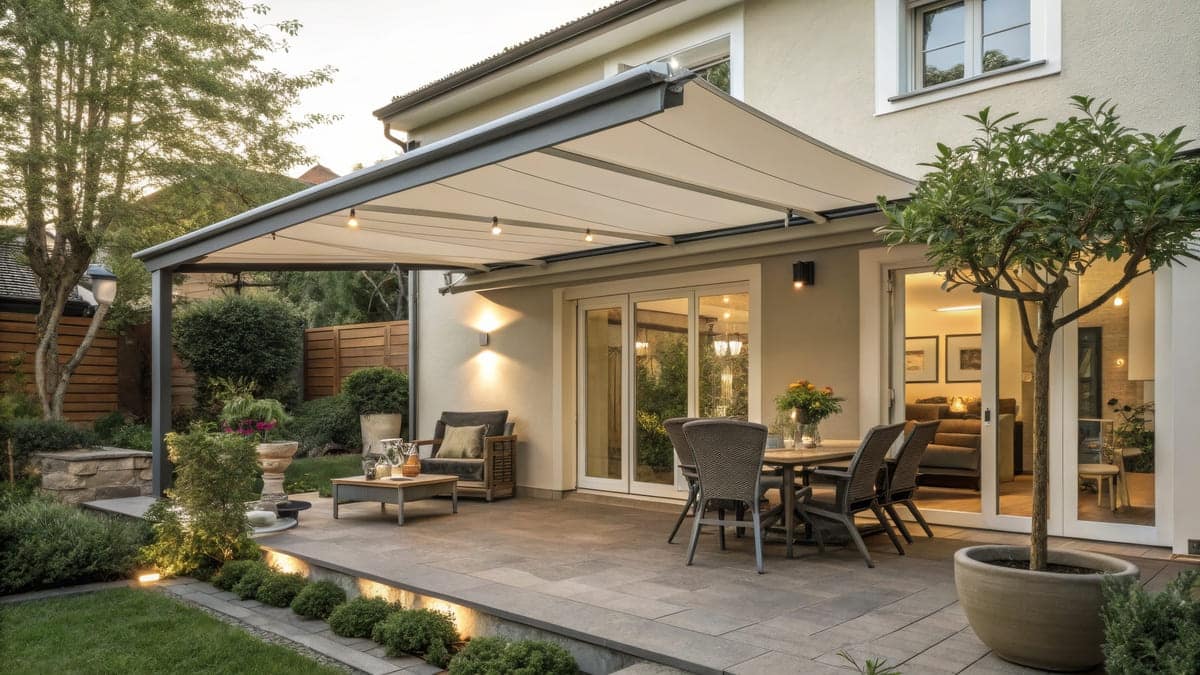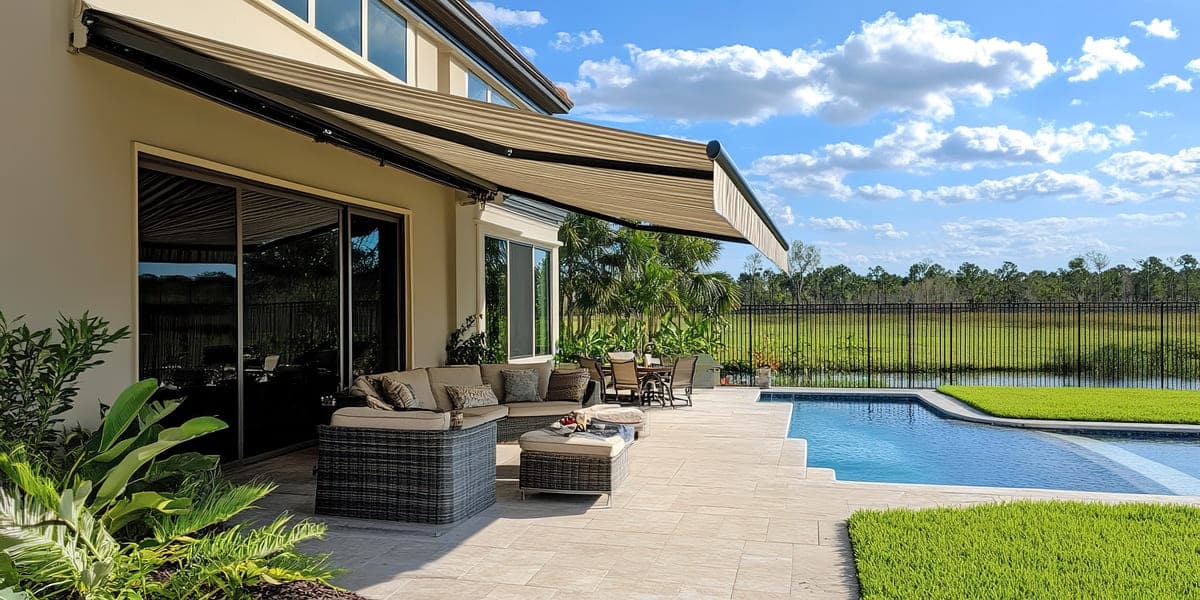Avoid These Costly Maintenance Errors with Your Awnings
Essential Tips for Prolonging Awning Life
Maintaining your awnings is vital for their longevity and performance. Avoid these common pitfalls to save on costly repairs:
- Overlooking Regular Maintenance: Dirt and debris can weaken fabric, while unchecked mechanical components may fail. Regular cleaning and inspections preserve awning integrity.
- Neglecting Sensor Calibration: Properly calibrated sensors retract awnings during adverse weather, preventing damage. Regular checks ensure optimal protection.
Enhancing Longevity
Regular maintenance significantly extends awning lifespan. Clean fabrics and well-maintained mechanics reduce wear and tear, while aligned sensors offer automatic protection against harsh weather.
Financial Benefits of Preventive Care
Preventive maintenance reduces repair costs. By addressing potential issues early, you avoid expensive fabric replacements and motor repairs.
How The Outdoor Living Group Supports You
The Outdoor Living Group offers expert consultation to maintain your awnings. Our tailored plans suit specific models, ensuring they remain in top condition. We provide professional cleaning and mechanical inspections to keep your awnings functioning optimally.
Book a consultation today to protect your investment and enjoy peace of mind with our expert care.
How to Properly Clean Your Awnings
Preserving the quality of your awnings requires a thoughtful approach and the right techniques. Here’s how to ensure your awnings remain in excellent condition.
Eco-Friendly Cleaning Tips
Opt for mild, non-abrasive detergents to maintain fabric integrity. Avoid harsh chemicals like bleach, which can degrade materials over time. Instead, choose eco-friendly solutions that protect both your awnings and the environment, aligning with sustainable practices.
Establishing a Cleaning Routine
Regular cleaning is essential. Aim to clean your awnings every three months. In areas with high pollen or pollution, consider more frequent cleanings. After storms, inspect and clean promptly to prevent long-term damage.
Effective Cleaning Techniques
Begin by gently brushing off loose debris. Use a soft cloth or sponge with lukewarm water to wash the fabric, avoiding abrasive materials. Rinse thoroughly to remove all residues, preserving the fabric’s texture and colour.
Advantages of Consistent Cleaning
Regular maintenance not only enhances the aesthetic appeal of your awnings but also extends their lifespan. By preventing material deterioration, you ensure your outdoor spaces remain inviting and well-protected.
By following these guidelines, you can enjoy the full benefits of your awnings while preserving their quality and appearance for years to come.

Why Regular Inspections Are Crucial
Regular inspections are essential for maintaining the longevity and functionality of your awnings. By identifying potential issues early, you can avoid costly repairs and ensure your outdoor spaces remain protected.
Key Inspection Elements
- Fabric Check: Inspect for signs of fraying, discoloration, or sagging, which may indicate tension issues or material wear.
- Mechanical Assessment: Ensure motors and arms function smoothly, free from unusual noises that suggest wear or misalignment.
- Sensor Calibration: Confirm sensors are responsive and accurately calibrated to retract awnings during adverse weather.
- Structural Review: Verify that mounts and brackets are secure and free from rust or damage.
Optimal Inspection Frequency
Conduct inspections at least twice annually, ideally before and after peak usage seasons. In areas with extreme weather or high usage, consider more frequent checks to maintain optimal performance.
Recognising Wear and Tear
- Loose Fabric: Indicates tension issues needing adjustment.
- Unusual Noises: Suggest mechanical wear or misalignment.
- Delayed Sensor Response: Points to calibration needs or potential sensor failure.
Preventive Actions Through Inspections
- Secure Fittings: Tighten loose components to prevent further damage.
- Lubricate Moving Parts: Regularly clean and lubricate to prevent rust and ensure smooth operation.
- Adjust Sensors: Enhance automatic retraction settings to protect against sudden weather changes.
Regular inspections not only prevent unexpected failures but also extend the lifespan of your awnings, preserving their aesthetic appeal and investment value. By maintaining optimal performance, inspections contribute to energy efficiency and user comfort, ensuring your outdoor spaces remain inviting and well-protected.
What Materials Enhance Awning Durability
Selecting the right materials for your awnings is essential for longevity and reduced maintenance. At The Outdoor Living Group, we prioritise high-quality materials that blend resilience with aesthetic appeal.
Durable Materials for Awnings
- Acrylic and Polyester Fabrics: Known for their UV resistance, these fabrics withstand harsh weather, keeping your awnings vibrant and intact.
- Powder-Coated Aluminium Frames: These frames resist corrosion and rust, maintaining structural integrity in challenging environments.
Impact of Material Choice on Maintenance
Choosing durable materials minimises maintenance frequency and costs. High-quality fabrics and robust frames reduce wear and tear, preventing frequent repairs or replacements. This not only saves money but ensures optimal awning performance.
Advantages of Weather-Resistant Materials
Weather-resistant materials shield your awnings from the elements. By selecting fabrics and frames designed to resist UV rays, rain, and wind, you extend their lifespan. This durability means fewer maintenance interventions, allowing uninterrupted enjoyment of your outdoor spaces.
Cost-Effectiveness of Quality Materials
Investing in durable materials may have a higher initial cost, but the long-term savings are substantial. By reducing the need for frequent maintenance and replacements, you lower overall expenses and increase the lifespan of your awnings. This cost-benefit analysis highlights the value of choosing quality over cheaper, less durable options.
Forward-Looking Insights
Embrace the future of outdoor living with materials that promise durability and sustainability. The Outdoor Living Group is committed to providing solutions that not only meet your needs today but also anticipate tomorrow’s challenges.
Emotional Connection
Imagine awnings that not only protect but also enhance your outdoor experience. With The Outdoor Living Group, your vision becomes reality, supported by materials that stand the test of time.
Differentiators
Our commitment to quality and sustainability sets us apart. Choose The Outdoor Living Group for awnings that offer both performance and peace of mind.

When to Seek Professional Maintenance
Recognising the right moment to engage professional maintenance can safeguard your investment and extend the life of your awnings. Here are key indicators that it’s time to call in the experts:
- Mechanical Concerns: Unusual noises or erratic movements suggest underlying issues needing professional diagnostics.
- Wear and Tear: Fraying fabrics or rusting frames signal the need for expert intervention to prevent further damage.
- Sensor Malfunctions: Inconsistent sensor performance during adverse weather highlights the need for professional calibration.
Benefits of Professional Services
Opting for professional maintenance offers numerous advantages:
- Precision Diagnostics: Experts utilise specialised tools to accurately diagnose and address issues, ensuring comprehensive care.
- Holistic Care: Every component, from fabric to frame, receives meticulous attention, enhancing performance and longevity.
- Quality Assurance: High-quality replacement parts are used, preserving both function and aesthetic appeal.
What to Expect from Maintenance Providers
Professional maintenance services provide:
- Comprehensive Reports: Detailed inspections outline current issues and potential risks.
- Clear Communication: Transparent explanations of necessary repairs and costs, ensuring no surprises.
- Scheduled Follow-Ups: Regular checks maintain optimal condition and prevent future issues.
Preventive Advantages of Professional Care
Engaging professionals not only resolves existing problems but also offers preventive benefits:
- Early Detection: Minor issues are identified before escalating into costly repairs.
- Consistent Maintenance: Regular services prevent unexpected breakdowns and enhance reliability.
- Efficiency Boost: Consistent care improves energy efficiency, reducing operational costs over time.
Choosing professional maintenance over DIY ensures a comprehensive approach, addressing both visible and hidden issues with precision. This proactive strategy not only protects your investment but also enhances the enjoyment of your outdoor spaces.
How to Store Awnings During Off-Season
Properly storing your awnings during the off-season is crucial for maintaining their longevity and aesthetic appeal. Neglecting this step can lead to unnecessary wear and tear. Here’s how to store them effectively:
Best Practices for Awning Storage
- Thorough Cleaning: Remove all dirt and debris to prevent mould and mildew, which can degrade the fabric over time.
- Complete Drying: Ensure your awnings are entirely dry before storage to avoid fabric damage and unpleasant odours.
- Protective Covers: Use breathable covers to shield your awnings from dust and pests, keeping them in pristine condition.
Preventing Damage During Storage
- Avoid Sharp Folds: Roll your awnings instead of folding them to prevent creases and stress on the fabric.
- Optimal Environment: Store in a dry, cool place to protect against extreme temperatures and humidity, which can weaken materials.
Necessary Materials for Storage
- Breathable Covers: These prevent moisture buildup and allow air circulation, preserving fabric integrity.
- Storage Racks or Hooks: Keep awnings off the ground to avoid contact with dirt and pests, ensuring they remain clean and safe.
Benefits of Seasonal Storage
- Extends Longevity: By limiting exposure to harsh elements, you reduce wear and tear, significantly extending the life of your awnings.
- Maintains Aesthetic Appeal: Proper storage helps preserve the vibrant colours and texture of the fabric, keeping your outdoor space looking fresh.
Impact of Storage on Longevity
Consider climate conditions when storing awnings. In humid regions, additional moisture control measures, like silica gel packs, can be beneficial. Space-saving tips, such as vertical storage solutions, can also optimise your storage area.
By following these guidelines, you can ensure your awnings are well-protected during the off-season, ready to enhance your outdoor space when needed.
Can DIY Repairs Be Effective?
DIY repairs offer a practical, cost-effective solution for minor awning issues, allowing you to maintain your outdoor spaces efficiently. However, understanding their limitations is crucial to prevent exacerbating problems.
Common DIY Repair Techniques
- Fabric Patching: Utilise repair kits for small tears, ensuring surfaces are clean and dry before application.
- Tightening Bolts: Regularly check and secure all fasteners to uphold structural stability.
- Lubrication: Apply silicone spray to moving parts to avert rust and ensure smooth operation.
When to Attempt DIY Repairs
DIY repairs suit straightforward issues within your skill set, like minor fabric damage or simple mechanical tweaks. Avoid DIY for electrical components or complex mechanisms, as mishandling can cause further damage.
Risks of Improper DIY Maintenance
Improper DIY repairs may void warranties and pose safety risks. Using non-approved methods or materials can worsen issues, leading to costly professional interventions. Assess the repair complexity and your ability to execute it safely.
Balancing DIY and Professional Care
DIY efforts can complement professional maintenance by promptly addressing minor issues, serving as a first line of defence. Regular professional inspections remain vital, identifying hidden problems and ensuring comprehensive care. This balanced approach maximises awning longevity and performance.
By integrating DIY repairs with professional services, you preserve the structural integrity and aesthetic appeal of your awnings, ensuring they continue to enhance your outdoor spaces effectively.
Contact The Outdoor Living Group Today
Enhance your outdoor space with expert care from The Outdoor Living Group. Our tailored solutions ensure your investment remains pristine and functional throughout the year.
- Customised Maintenance Plans: Our team designs bespoke plans that cater to your unique needs, ensuring your awnings perform optimally and last longer.
- Expert Consultation: Engage with our specialists to discover how our services can elevate your outdoor living experience. We provide personalised insights and recommendations.
- Comprehensive Care Services: From routine inspections to advanced repairs, our offerings cover all aspects of outdoor maintenance, protecting your investment.
- Sustainable Solutions: We prioritise eco-friendly practices, ensuring that our maintenance services not only preserve your awnings but also align with environmental goals.
By choosing The Outdoor Living Group, you benefit from a team committed to excellence and innovation. Our dedication to quality and customer satisfaction ensures your outdoor spaces are always in expert hands. Whether you’re a homeowner enhancing your garden or a business owner impressing clients, our services are designed to meet and exceed your expectations.
FAQs
How Often Should I Clean My Awnings?
Why Regular Cleaning Matters
Consistent cleaning prevents dirt and debris from accumulating, which can lead to fabric damage and mechanical issues. Awnings exposed to elements like pollen, dust, and pollution need more frequent care to maintain their integrity.Factors Affecting Cleaning Frequency
- Environmental Conditions: High levels of pollen or pollution demand more frequent cleaning to prevent material degradation.
- Weather Exposure: Awnings in areas with harsh weather, such as heavy rain or snow, require regular maintenance to avoid damage.
- Usage Patterns: Frequently used awnings gather dirt faster, necessitating more frequent cleaning.
Suggested Cleaning Schedule
- Routine Cleaning: Every three months to maintain optimal condition and performance.
- High Exposure Areas: Monthly cleaning in regions with high pollution or adverse weather.
- Post-Storm Care: Immediate cleaning after severe weather to prevent long-term damage.
Benefits of Consistent Cleaning
Regular maintenance extends the lifespan of awnings by preventing material deterioration and maintaining structural integrity. It reduces wear and tear by removing harmful substances that can weaken materials over time.Risks of Neglecting Cleaning
- Fabric Damage: Accumulated dirt can stain and weaken fabric fibres, leading to costly repairs.
- Mechanical Issues: Dirt buildup can impair moving parts, causing mechanical failures.
- Aesthetic Decline: Neglected awnings lose their visual appeal, affecting your outdoor space's overall look.
What Are the Signs of Awning Damage?
Visual Indicators of Wear
- Fading Colours: Sun exposure can dull vibrant fabrics, a sign of UV damage.
- Frayed or Torn Edges: These suggest material degradation from weather or stress.
- Sagging Fabric: This may indicate weakened support or fabric stretching.
Functional Signs of Trouble
- Strange Noises: Grinding or squeaking during operation often signals mechanical wear or misalignment.
- Slow Retraction: Delays in retraction could point to sensor or motor issues.
- Operational Resistance: Difficulty in extending or retracting may suggest alignment problems or worn parts.
The Value of Early Detection
Catching damage early is crucial for maintaining both the functionality and aesthetics of your awnings. Addressing issues promptly prevents minor problems from escalating, saving time and resources. Regular inspections and maintenance are key to identifying potential problems before they become costly.Steps to Tackle Damage
- Regular Inspections: Consistently check your awnings for wear or damage.
- Immediate Repairs: Prioritise fixing critical issues like motor or sensor failures to prevent further damage.
- Scheduled Maintenance: Establish a routine maintenance plan to ensure your awnings perform optimally and last longer.
Why Is Professional Maintenance Recommended?
Expertise and Tools Professionals Provide
- Advanced Diagnostics: Experts utilise specialised tools to uncover hidden issues, ensuring comprehensive care.
- High-Quality Parts: Access to superior replacement parts maintains the structural integrity and functionality of your awnings.
- Expert Training: Professionals are trained to handle complex systems, performing precise adjustments that DIY methods might overlook.
Long-term Benefits of Professional Care
- Extended Lifespan: Regular professional maintenance prevents wear and tear, significantly extending the life of your awnings.
- Cost Savings: Early detection of issues by professionals prevents costly repairs, saving you money.
- Enhanced Performance: Expert care ensures smooth and reliable operation, providing peace of mind.
When to Call in the Experts
- Electrical Malfunctions: Complex electrical issues require professional expertise to avoid further damage.
- Sensor Calibration: Accurate calibration by professionals ensures sensors function correctly, protecting your awnings from adverse weather.
- Persistent Operational Issues: Unusual noises or movements signal the need for expert intervention.
DIY vs. Professional Maintenance
- Thoroughness: Professional inspections are more comprehensive, identifying issues that might go unnoticed.
- Warranty Protection: Professional services maintain warranties, offering added security.
- Peace of Mind: Knowing your awnings are in expert hands provides reassurance that DIY efforts can't match.
Forward-Looking Insights
Embrace the future of outdoor living with sustainable practices and expert care. The Outdoor Living Group is committed to providing solutions that not only meet your needs today but also anticipate tomorrow's challenges.What Materials Are Best for Awnings?
Superior Materials for Awning Construction
- Acrylic and Polyester Fabrics: These fabrics are renowned for their UV resistance, enduring harsh weather while maintaining vibrant colours.
- Powder-Coated Aluminium Frames: Offering exceptional corrosion resistance, these frames ensure structural integrity in challenging environments.
Influence of Material Choice on Maintenance
High-quality materials significantly reduce maintenance needs and costs. Durable fabrics and frames minimise wear, preventing frequent repairs. This not only saves money but ensures consistent performance.Advantages of Weather-Resistant Materials
Weather-resistant materials provide essential protection against the elements. By selecting fabrics and frames designed to withstand UV rays, rain, and wind, you extend the lifespan of your awnings. This durability means fewer maintenance interventions, allowing uninterrupted enjoyment of your outdoor spaces.Cost-Effectiveness of Quality Materials
While investing in durable materials may have a higher initial cost, the long-term savings are substantial. By reducing the need for frequent maintenance and replacements, you lower overall expenses and increase the lifespan of your awnings. This cost-benefit analysis underscores the value of choosing quality over cheaper, less durable options. Our commitment to using high-quality, weather-resistant materials ensures that your awnings not only enhance your outdoor space but also stand the test of time, providing a sustainable and cost-effective solution.How Can I Prevent Awning Damage?
Proactive Maintenance Practices
- Routine Cleaning: Regularly clear dirt and debris to preserve fabric integrity. Opt for mild detergents and soft brushes to maintain material quality.
- Mechanical Inspections: Check motors and arms for smooth operation. Address any unusual sounds or resistance promptly to prevent further issues.
- Sensor Calibration: Ensure sensors are precisely calibrated to retract awnings during adverse weather, safeguarding them from potential harm.
Weather Protection Strategies
- Retract During Storms: Always retract awnings in high winds or heavy rain to avoid structural damage.
- Select Weather-Resistant Materials: Choose awnings crafted from UV-resistant acrylic fabrics and powder-coated aluminium frames for enhanced durability.
Importance of Regular Inspections
- Bi-Annual Checks: Conduct thorough inspections at least twice a year to identify and resolve potential issues early.
- Post-Storm Assessments: After severe weather, inspect your awnings for any signs of damage or wear.
Role of Quality Materials
- Durable Fabrics: Opt for UV-resistant acrylic or polyester fabrics to withstand harsh conditions and maintain vibrant colours.
- Sturdy Frames: Use powder-coated aluminium frames to resist corrosion and ensure structural integrity.
Extending Awning Lifespan Through Preventive Care
Investing in regular maintenance and high-quality materials not only reduces repair costs but also extends the lifespan of your awnings. This approach enhances both functionality and aesthetic appeal, allowing uninterrupted enjoyment of your outdoor areas.Forward-Looking Insights
Embrace the future of outdoor living with smart technology integration and sustainable practices. The Outdoor Living Group offers solutions that anticipate tomorrow's challenges, ensuring your awnings remain a valuable asset.Emotional Connection
Imagine awnings that not only protect but also enhance your outdoor experience. With The Outdoor Living Group, your vision becomes reality, supported by materials that stand the test of time.Differentiators
Our commitment to quality and sustainability sets us apart. Choose The Outdoor Living Group for awnings that offer both performance and peace of mind.Can DIY Repairs Save Money?
Practical DIY Repair Techniques
- Patch Small Tears: Use repair kits to mend minor fabric damage. Ensure surfaces are clean and dry for effective adhesion.
- Tighten Fasteners: Regularly check and secure all fasteners to maintain structural stability.
- Lubricate Components: Apply silicone spray to moving parts to prevent rust and ensure smooth operation.







